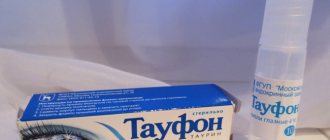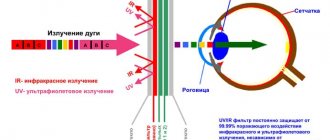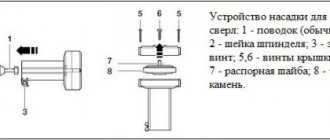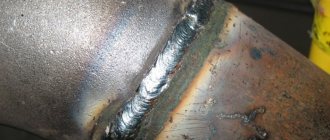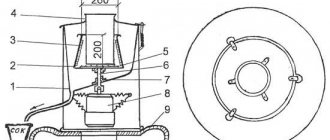What causes electroophthalmia?
We know that when looking at bright light our eyes experience significant discomfort. This is easy to notice if you look at the sun, but the discomfort will pass after a while. But some light burns have very negative consequences. Welders are constantly at risk of such eye burns. A plasma or electric arc that is constantly in front of a worker’s eyes poses a great danger to his eyes. Of course, welders take personal eye protection measures by wearing special masks, but cases of eye burns constantly occur in this area of production. This injury is called electroophthalmia. What should you do if your eyes are burned during welding, and what consequences may arise?
Causes of eye pain from welding
Electroophthalmia is a sensation of intense pain and burning in the eyeballs that occurs when working with welding equipment. Most often, the reason for watery eyes after welding is a careless attitude to compliance with the basic safety principles when using electric welding equipment.
The pain in the eyes when welding is a consequence of the fact that the worker inhales a huge amount of fumes from hot metal, and also looks at the electric arc that occurs as a result of specific ultraviolet radiation. If a person has seen enough of welding, he develops a burn to the eye, since the cornea is one of the hypersensitive and susceptible tissues. This process is accompanied by inflammation and sharp pain.
The degree of damage to the ocular structure and the symptoms of electroophthalmia directly depend on the cause of this condition:
- poor-quality mask - the presence of gaps between the protective device and the light filters allows harmful rays to penetrate directly into the eyes;
- independent assembly of metal structures, which is most often carried out without a protective mask;
- protective equipment that does not meet the complexity of the work being carried out;
- A common cause of eye burns is being in close proximity to a welding machine.
Electroophthalmia during welding has 4 main forms of severity, on the basis of which the most optimal and fast-acting method of treatment is selected. The following types of retinal injury are distinguished:
- Mild – a slight burning sensation and discomfort, redness of the retina, blurred vision.
- Medium – accompanied by increased photosensitivity, intense pain, and the formation of a film coating on the conjunctiva.
- Severe – the eyes and the skin around them become swollen and red, the victim feels intense pain and burning, and the quality of his vision is greatly deteriorated.
- Very severe – characterized by colorlessness of the cornea, development of blindness, and tissue death.
The extreme degree of electroophthalmia is accompanied by pain of such intensity that the victim simply cannot open his eyelids. The most common outcome of this grade is complete blindness and necrosis of the ocular cornea.
Symptoms of injury
Electroophthalmia has several degrees of severity depending on the severity of the burn. Accordingly, the symptoms of injury vary. However, it does not necessarily come from looking at a sparkling arc, but a thermal burn may occur in the absence of a mask from high temperature. However, most often this is a light burn of the mucous membrane, which negatively affects the cornea and retina.
Common signs of such visual damage are:
- photophobia;
- severe lacrimation;
- redness of the whites;
- acute pain in the eyes;
- spasms of the eyelids.
After receiving an injury, you should visit a doctor as soon as possible to determine the severity of the injury. Indeed, with significant damage, vision may deteriorate and irreversible changes in the structures of the eyes may occur.
A little medicine
The outside of the eye is covered with a special transparent structure called the cornea. It is a lens consisting of transparent connective tissue covered on the outside with epithelium. Its cells are capable of absorbing ultraviolet radiation. The reaction of the cornea to UV rays depends on their wavelength, time and intensity of exposure. With prolonged exposure to a powerful stream of short-wave UV radiation, the DNA of epithelial cells is destroyed. As a result, their death develops, which manifests itself in the form of a burn.
In response to UV rays, an inflammatory reaction occurs in the cornea, which is characterized by four classic symptoms:
- swelling;
- redness;
- increased body temperature;
- pain.
These clinical signs develop due to the reaction of blood vessels and nerves entwining the anterior surface of the eyeball.
Under the influence of UV rays, small capillaries located at the junction of the cornea and the sclera expand, causing it to swell. Dilated, blood-filled vessels of the conjunctiva give it a red color.
The cornea is rich in nerve endings, so any damage to it causes severe pain.
Full restoration of its functions occurs within 3-4 days.
A distinctive feature of a burn with UV rays from thermal and chemical burns is that its effect is cumulative, that is, accumulative. Symptoms do not appear immediately after exposure, but appear gradually, reaching a maximum 6-12 hours after injury.
What are the degrees of burn?
In total, there are four degrees of severity of eye burns from welding, depending on this, the appropriate method of therapy is selected.
First degree . It is characterized by severe itching, burning, and the cornea may become cloudy. Signs of irritation in the first degree may go away on their own within a few days, and no therapy will be needed. Second degree . There is acute pain in the eyes, photophobia, and a film may form on the conjunctiva. The second degree refers to the average. Third degree . A severe form of the disease, in which acute pain turns into aching pain, the eyelids visibly swell, vision becomes blurry, and bright flashing flashes appear in the eyes - they are also called “welding bunnies.” There is a feeling of sand or a foreign body under the eyelids. Fourth degree . A very dangerous form of electroophthalmia. As a result of such a burn, necrosis (tissue death) may begin, the eyelids cease to open fully, and the cornea becomes whitish.
After receiving a burn, you need to take the first preventive measures (rinsing with purified water, cold compress on the eyes, taking an anesthetic) and wait for the doctor to arrive or visit him yourself. It is dangerous to use drops in the eyes, the pharmacological effects of which you do not know. Some liquids contain preservatives, which slow down the regeneration process and provoke even greater inflammation. Only a specialist can prescribe the appropriate remedies.
First aid
Sometimes workers using a welding machine do not pay attention to discomfort and pain in the eye area. This is not correct, since only timely qualified assistance can preserve vision and improve the condition of the victim.
If signs of electroophthalmia are detected, then it is necessary:
- Prescribe a pain reliever, for example, analgin or ketanov. Additionally, you need to give an anti-inflammatory drug (tavegil, diclofenac).
- Rinse your eyes with clean water; you can use still water for drinking.
- Remove, if any, foreign objects from the surface of the cornea (usually metal shavings). To do this, use cotton pads or napkins, which must be sterile.
- A cold compress is placed on the eyelids to reduce swelling and inflammation.
- Treat the surface with antibacterial or antiseptic ointment (for example, tetracycline).
After emergency measures are taken, the victim must be taken to an ophthalmologist as soon as possible, who will conduct the necessary diagnostics and prescribe treatment.
Prevention
Burns to the eye cornea as a result of electric welding can be prevented if maximum attention is paid to compliance with the most important personal safety rules. When using a welding machine, be sure to wear properly selected safety glasses or a mask.
All work equipment must be in good working order and thoroughly checked. It is under no circumstances recommended for strangers to look at welding work, as this can cause burns. Welders should take breaks and give their vision proper rest.
What happens to the eyes during welding and what are the consequences?
Welding is not only the joining of metal parts; it is also used when working with other materials. Electric current is used as a source of formation of the welding arc. So what exactly causes harm?
When welding, rays of three spectra are released at once: infrared, ultraviolet and light. The intensity is too high for the human eye, it exceeds the permissible level.
There is a common expression among welders: “catching a bunny.” This means that the cornea of the eye has been burned. We do not perceive infrared and ultraviolet rays with our eyes, but they have a very intense effect on the eyes. Moreover, negatively. Damaging the mucous membrane, retina and lens of the eye, causing a burn.
The main eye disease that occurs under the influence of light radiation from welding is electroophthalmia.
What other causes of eye damage from welding are there?
- Negligent attitude towards work. Often welders do not use special safety glasses, which are required to be used for safety reasons. Or the use of low-quality glasses purchased in order to save money;
- Smoke effects on the mucous membranes of the eyes;
- Release of gases affecting the eyes;
- Foreign body getting into the eye. Most often, these are very small pieces of metal that stick into the cornea.
Let's sum it up
Eye burns are a fairly common disease among welders caused by neglect of safety rules. At the slightest suspicion of electroophthalmia, it is important to stop all work and provide yourself with simple first aid. The healing process for an eye burn must be completed before the welder can return to work. The main means for treating eye burns are eye drops. In their mass, they differ in their principle of action and should be taken as prescribed by a doctor or after reading the instructions. It is important not to exceed the indicated doses, and if treatment does not produce results, seek qualified help.
What not to do?
Many people prefer not to see a doctor, but to solve the problem at home, through self-medication or traditional medicine. Meanwhile, there are a number of contraindications for ophthalmic burns.
- You should not put aloe juice or honey in your eyes.
- Do not rinse eyes excessively with tap water. It's better to take bottled water.
- Don't rub your eyes.
- Do not use the first eye drops you come across. They all have different compositions and different effects. The likelihood of making the situation worse is very high.
Drops for corneal restoration
In addition to the main treatment for a burn, active restoration of the mucous membrane is required. For this purpose, medications that have a reparative and regenerative effect are used.
Revitalizing drops:
- Emoxipine is used for the treatment and prevention of burns and hemorrhage in the sclera. The antioxidant agent is used 1-2 drops. up to 3 times a day Emoxipin can be used for 30 days. If the medicine is well tolerated, treatment is extended to 6 months.
- Derinat is an immunomodulatory agent. It forms systemic immunity, allowing tissues to regenerate faster. Derinat activates the lymphatic system, reduces the severity of inflammation. Can be used during pregnancy.
- Actovegin is an eye gel. Activates metabolic processes, stimulates tissue regeneration and trophism. Actovegin is used for therapeutic and prophylactic purposes.
- Sicaprotect is a remedy used for diseases when the patient cannot mechanically close the eyelids. It improves tear secretion, accelerates healing and restoration of the mucous membrane. Use up to 6 times a day, 1 drop. into the affected organ of vision.
- Korneregel stimulates the healing process. Recommended for use on burns of any degree.
- Vitasik activates cellular metabolism. The drops restore the corneal epithelium with long-term use. After opening the bottle, Vitasik should be used within 2 weeks.
Drops with both antioxidant properties and vitamins are also prescribed to restore the cornea.
Drops for the treatment of the first stage
At the first stage of a burn to the organs of vision, drops are used to relieve inflammation, relieve pain and constrict blood vessels. These medications help reduce inflammation, redness, and provide short-term pain relief:
- Proculin;
- Lidocaine;
- Visine;
- Tetracaine;
- Alcaine;
- Diclofenac;
- Diklo-F;
- Visoptic;
- Visoptin.
These drugs help relieve all signs of the first stage of burns that the patient received from welding. Some of them create a freezing effect, relieving pain for a long time. It is not recommended to use such medications more than twice a day.
How long will the illness last?
If the eye is damaged by welding, symptoms may not appear until seven hours later. If the corneal layer is not damaged, the disease will last several days. You will notice: lacrimation, photophobia, anxiety. Over time this will pass. If the presence of a burn is established, the doctor will prescribe treatment, the duration of which is directly dependent on how severe the injury is. Even after completing the full course, discomfort may occur.
There is no need to hope that a thermal burn will go away quickly. It may take a long time for complete recovery. Therefore, even if you feel relief, complete the full course of treatment prescribed by your doctor. In order not to miss procedures, it is better to issue a sick leave.
When to see a doctor
In case of sharp spasms that do not disappear for more than 72 hours, rapid deterioration of vision, or the inability to fully look at a source of bright light, it is not recommended to self-medicate, you should consult an ophthalmologist. This will prevent the severe consequences of electroophthalmia from developing.
Any deterioration in the victim’s well-being after first aid measures and the use of medications is a serious reason for an urgent visit to an ophthalmologist.
